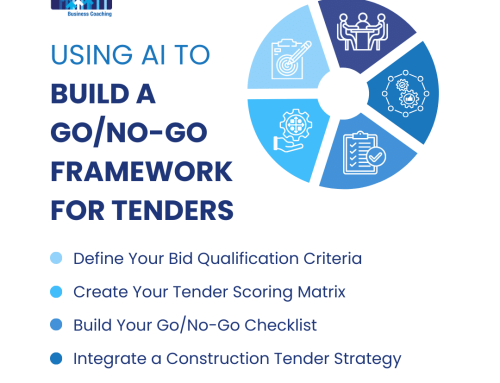AI for Tradies: Tips for Winning Tenders
Winning tenders isn’t just about quoting the lowest price; it’s about choosing the right opportunities, understanding what clients truly value, and presenting your business as the best fit for the job. From selecting tenders that match your team’s capacity to crafting compelling case studies and pricing your bid strategically, each step requires clarity and confidence. In this article, you’ll learn how to use the free version of ChatGPT to turn high-level tender strategy into practical, daily actions that improve your chances of success.
I’m Ashley Thomson, a tradie business coach who helps trade professionals build smarter systems, win better work, and grow their businesses with confidence. This guide builds on my original article, “Tradie Business 101: Tips for Winning Tenders,” and shows how AI can support your tendering process without the need for complex tools or technical jargon.
Selecting Tenders
Target Relevant Tenders
The original advice is about concentrating on tenders that match your core skills, project size, and team capacity instead of chasing every opportunity. You avoid wasting effort by focusing on the ones you’re best suited to win.
ChatGPT can help you review tender descriptions and highlight those that match your services. You can paste criteria into the chat and ask for an assessment of fit. It reduces your research time and helps you focus on what matters most.
Prompt 1
“Review this tender description for a small commercial electrical fit-out and tell me if my business, specialising in maintenance and installation under $200 000, is a good fit.”
Prompt 2
“Compare these three tender notices and rank them by how well they match a mid-sized plumbing company’s services.”
Prompt 3
“Identify key phrases from this tender that indicate suitability for an HVAC installer with a team of five technicians.”
Prompt 4
“Summarise these government tender requirements and tell me which match my carpentry business’s standard project range.”
Consider your Current Team
In the original article, I reminded you to check whether you have the right number of staff or if you’ll need to recruit, and to account for higher labour costs in your pricing when the market is tight. It’s about honest capacity planning before you bid.
ChatGPT can assist you in modelling team availability and wage impacts by requesting simple tables or scenarios. You can prompt it to estimate costs for additional hires or to identify where efficiencies might free up existing staff. This provides a quick reality check on whether you can realistically deliver.
Prompt 1
“Given I have three electricians working full time and one apprentice at 60 per cent, estimate total labour hours available in a month.”
Prompt 2
“Calculate additional labour cost if I need two more plumbers at $45/hour for a six-month maintenance contract.”
Prompt 3
“Suggest ways to redeploy my carpenters’ time to handle a new contract requiring 150 labour hours per week.”
Prompt 4
“Outline a staffing plan for an HVAC installation tender requiring 1,000 labour hours over eight weeks.”
Gathering Intel
Understand the Submission Requirements Inside Out
Here I emphasised the importance of reading every line of the tender documents, noting deadlines and mandatory qualifications, and ensuring nothing is overlooked. It’s about satisfying all requirements.
With ChatGPT, you can paste the tender section you’re unsure about and ask for a simple explanation or a checklist of requirements. It helps you avoid missing important clauses and gives you confidence that your bid will be compliant.
Prompt 1
“Summarise these tender conditions into a checklist of mandatory qualifications and documents required for submission.”
Prompt 2
“Explain in simple terms what ‘compliance with AS/NZS 3500 plumbing standards’ means for my proposal.”
Prompt 3
“Highlight all deadline dates and deliverable milestones from this tender document excerpt.”
Prompt 4
“Generate a table mapping each requirement in this RFP to the corresponding evidence I need to attach.”
Understand the Critical Success Factors for the Project
My original article highlighted that price isn’t always the most important. Clients might prioritise uptime, safety or sustainability above all else. You need to find out what influences their decision so you can customise your bid.
ChatGPT can review client newsletters, annual reports, or project briefs you provide to identify those critical success factors. Then, you can tailor your responses around what they genuinely care about instead of guessing.
Prompt 1
“Analyse this client’s annual report and list three priority outcomes they emphasise for maintenance contractors.”
Prompt 2
“Read this project brief and identify the success metrics the client uses to judge contractor performance.”
Prompt 3
“Summarise key sustainability goals from this council’s procurement policy relevant to my landscaping bid.”
Prompt 4
“Explain why reducing downtime is critical for an aircraft maintenance tender and how to frame that in my response.”
Attend Pre-Tender Briefings
I pointed out that attending a briefing demonstrates commitment, provides clarity on project details, and helps you gauge competitor presence. It’s both research and relationship building in one.
ChatGPT can help you prepare a list of smart questions to ask at a briefing so you come across as informed and professional. It can also assist you in organising notes afterwards, turning your insights into bid-winning language.
Prompt 1
“Create ten questions to ask at a pre-tender briefing for a government electrical upgrade project.”
Prompt 2
“After this briefing transcript, summarise the client’s main concerns and how we can address them in our bid.”
Prompt 3
“Draft a follow-up email thanking the procurement team for the briefing and clarifying two technical points.”
Prompt 4
“List three competitor strategies that might interest us based on the questions other attendees asked at the briefing.”
Preparing a Winning Bid
Show experience from past projects
I recommended you highlight similar jobs your team has completed and clearly draw parallels in skills, scale, and outcomes. That enhances credibility and relevance in your submission.
ChatGPT can create case study stories from project details you provide. It will help highlight the parts most important to the client, like timing, quality, or cost savings, and format it neatly for your tender.
Prompt 1
“Write a case study summary for a $150 000 commercial fit-out we completed, emphasising on-time delivery.”
Prompt 2
“Draft three bullet points comparing our past HVAC installation in a school to this tender’s requirements.”
Prompt 3
“Generate a project overview paragraph highlighting safety and quality control in our plumbing maintenance work.”
Prompt 4
“Rewrite this client testimonial to include specific metrics on budget adherence and schedule performance.”
Demonstrate Agility and Problem-Solving
In the original article, I suggested you provide one or two examples of challenges you faced and how you overcame them, demonstrating adaptability and practical problem-solving.
ChatGPT can turn your raw notes into engaging stories that highlight your agile approach. You can ask it to refine your examples into short, clear narratives that connect with evaluators, showing your ability to adapt to the unexpected.
Prompt 1
“Turn these notes on a supply delay into a brief story showing how we kept a project on track.”
Prompt 2
“Draft a problem-solving paragraph explaining how we redesigned a work sequence when site access changed.”
Prompt 3
“Summarise an example of cost overrun mitigation we enacted on a commercial build in three sentences.”
Prompt 4
“Rewrite this text to show how we adopted a new safety procedure mid-project to meet client requirements.”
Put AI to Work in Your Tendering Toolkit with a Tradie Business Coach
By using these prompts in the free version of ChatGPT, you will be able to turn a high-level tender strategy into actionable daily tasks. This process will help you save time, improve accuracy, and increase your chances of successfully winning tenders.
As a tradie business coach, I encourage you to experiment with different prompts, refine them as needed, and make this artificial intelligence tool a dependable part of your tendering toolkit. This approach is part of your broader trade business coaching journey and aims to support you every step of the way.
Ready to take your tendering game to the next level? Contact us today for tailored tradie business coaching services that help you win more work, streamline your operations, and grow with confidence.






